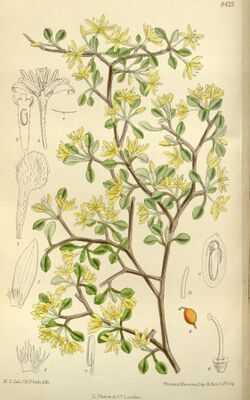Biology:Corokia cotoneaster
This article includes a list of references, related reading or external links, but its sources remain unclear because it lacks inline citations. (November 2021) (Learn how and when to remove this template message) |
| Corokia cotoneaster | |
|---|---|

| |
| Scientific classification | |
| Kingdom: | Plantae |
| Clade: | Tracheophytes |
| Clade: | Angiosperms |
| Clade: | Eudicots |
| Clade: | Asterids |
| Order: | Asterales |
| Family: | Argophyllaceae |
| Genus: | Corokia |
| Species: | C. cotoneaster
|
| Binomial name | |
| Corokia cotoneaster Raoul (1846)
| |
Corokia cotoneaster is a flowering plant in the family Argophyllaceae was described by Étienne Fiacre Louis Raoul in 1846. This plant is commonly known as the wire-netting bush, korokio, or korokia-tarango. The word "Koriko" comes from the Māori language.
Identifications
Corokia cotoneaster is a highly branched shrub with a strongly divaricating habit with rough dark-coloured bark, usually growing to about 3 m in height. Common variable shrubs with thin gray zig-zag twigs that contain small white clusters underneath with dented or rounded edges and on flat, black petioles. Yellow flowers, star-shaped and red fruits. The leaves are variable, depending on altitude and to the degree of exposure to wind, and are obvo-cuneate to obovate-oblong, 2–15 cm long and 1–10 cm wide. The leaves of juveniles are long and spathulate with 3 lobes. Flowers are borne in leaf axils or terminally in groups of 2 to 4 flowers with bright yellow petals. The main flowering season is December to January.[1]
Gallery
References
- ↑ Allen H. H (1982). Flora of New Zealand. 1. P D Hasselbery. p. 981.
- New Zealand Plant Conservation Network. (2020). Corokia cotoneaster. Retrieved from https://www.nzpcn.org.nz/flora/species/corokia-cotoneaster/
- Fisher, M. E., & Forde, M. L.(1994). Growing New Zealand Plants, Shrubs & Trees (pp. 35). New Zealand: David Bateman Ltd.
- Howell, C. J., Turnbull, D. K., & Turnbull, M. H. (2002). Moa Ghosts Exorcised? New Zealand's Divaricate Shrubs Avoid Photoinhibition. Functional Ecology, 16(2), pp. 232–240.
- Young, L. M., & Kelly, D. (9 April 2014). Current rates of fruit removal and seed dispersal in New Zealand fleshy-fruited mountain plants. New Zealand Journal of Ecology, 38(2)
- Smith-Dodsworth, J. C. (1991). New Zealand Native Shrubs and Climbers (pp. 29). New Zealand: David Bateman Ltd.
- MacFarlane, A. E. T., Kelly, D., & Briskie, J. V. (7 December 2015). Introduced blackbirds and song thrushes: useful substitutes for lost mid-sized native frugivores, or weed vectors?. New Zealand Journal of Ecology, 40(1). doi: 10.20417/nzjecol.40.9
- Riley, M. (1985). Shrubs & Small Trees (pp. 28). New Zealand: Viking Sevenseas Ltd.
Wikidata ☰ Q17479806 entry
 |






